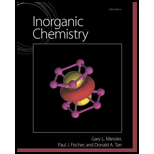
Concept explainers
Determine the energy of the transition from
Learn your wayIncludes step-by-step video

Chapter 2 Solutions
Inorganic Chemistry
Additional Science Textbook Solutions
Chemistry
General, Organic, and Biological Chemistry (3rd Edition)
Chemistry: An Introduction to General, Organic, and Biological Chemistry (13th Edition)
Chemistry: The Central Science (13th Edition)
Introductory Chemistry (5th Edition) (Standalone Book)
Chemistry: A Molecular Approach (4th Edition)
- In high-temperature sources, sodium atoms emit a doublet with an average wavelength of 1139 nm. The transition responsible is from the 4s to 3p state. Set up a spreadsheet to calculate the ratio of the numberof excited atoms in the 4s state to the number in the ground 3s state over the temperature range from anacetylene-oxygen flame (3000°C) to the hottest part of an inductively coupled plasma source (8750°C).arrow_forwardShow that the value of the Rydberg constant per photon, 2.179 1018 J, is equivalent to 1312 kJ/mol photons.arrow_forwardWhat is the physical explanation of the difference between a particle having the 3-D rotational wavefunction 3,2 and an identical particle having the wavefunction 3,2?arrow_forward
- The Lyman series of spectral lines for the H atom, in the ultraviolet region, arises from transitions from higher levels to n = 1. Calculate the frequency and wavelength of the least energetic line in this series.arrow_forwardIn a FranckHertz experiment on sodium atoms, the first excitation threshold occurs at 2.103 eV. Calculate the wavelength of emitted light expected just above this threshold. (Note: Sodium vapor lamps used in street lighting emit spectral lines with wavelengths 5891.8 and 5889.9 Å.)arrow_forwardList some unexplainable phenomena from the classical science and describe what could not be explained about them at the time.arrow_forward
- Write the steady-state symbol for the following atoms11Na , 37Rb , 55Cs , 87Fr , 3Liarrow_forwardWhat values of J may occur in the terms (i) 1S, (ii) 2P, (iii) 3P? How many states (distinguished by the quantum number MJ) belong to each level?arrow_forwardHow fast would a particle of mass 1.0 g need to travel to have the same linear momentum as a photon of rad iation of wavelength 300 nm?arrow_forward
- A glow-worm of mass 5.0 g emits red light (650 nm) with a power of 0.10 W entirely in the backward direction. To what speed will it have accelerated after 10 y if released into free space and assumed to live?arrow_forwardThe work function for cobalt metal is 8.01 x 10e-19J. What is the speed of the electrons ejected from cobalt when irradiated with 8.94e15 Hz light?arrow_forwardThe work function of an electron in zinc metal is 416 kk/mol .What is the longest wavelength of electromagnetic radiation that is still capable of removing an Adam from the sink metal surface in a vacuum?arrow_forward
 Chemistry: The Molecular ScienceChemistryISBN:9781285199047Author:John W. Moore, Conrad L. StanitskiPublisher:Cengage Learning
Chemistry: The Molecular ScienceChemistryISBN:9781285199047Author:John W. Moore, Conrad L. StanitskiPublisher:Cengage Learning Chemistry & Chemical ReactivityChemistryISBN:9781337399074Author:John C. Kotz, Paul M. Treichel, John Townsend, David TreichelPublisher:Cengage Learning
Chemistry & Chemical ReactivityChemistryISBN:9781337399074Author:John C. Kotz, Paul M. Treichel, John Townsend, David TreichelPublisher:Cengage Learning Principles of Modern ChemistryChemistryISBN:9781305079113Author:David W. Oxtoby, H. Pat Gillis, Laurie J. ButlerPublisher:Cengage Learning
Principles of Modern ChemistryChemistryISBN:9781305079113Author:David W. Oxtoby, H. Pat Gillis, Laurie J. ButlerPublisher:Cengage Learning Chemistry: Principles and PracticeChemistryISBN:9780534420123Author:Daniel L. Reger, Scott R. Goode, David W. Ball, Edward MercerPublisher:Cengage Learning
Chemistry: Principles and PracticeChemistryISBN:9780534420123Author:Daniel L. Reger, Scott R. Goode, David W. Ball, Edward MercerPublisher:Cengage Learning Principles of Instrumental AnalysisChemistryISBN:9781305577213Author:Douglas A. Skoog, F. James Holler, Stanley R. CrouchPublisher:Cengage Learning
Principles of Instrumental AnalysisChemistryISBN:9781305577213Author:Douglas A. Skoog, F. James Holler, Stanley R. CrouchPublisher:Cengage Learning Physical ChemistryChemistryISBN:9781133958437Author:Ball, David W. (david Warren), BAER, TomasPublisher:Wadsworth Cengage Learning,
Physical ChemistryChemistryISBN:9781133958437Author:Ball, David W. (david Warren), BAER, TomasPublisher:Wadsworth Cengage Learning,





